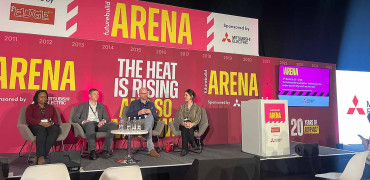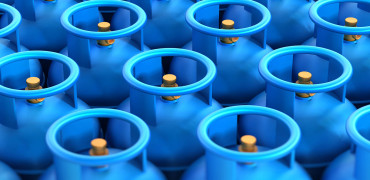Anyone involved in air conditioning and refrigeration will know all about the changes in refrigerants that are currently happening as we move towards ones that reduce the global warming potential (GWP) of the systems they are used in.
Which is why we have just introduced new air conditioning units that use R290, which has a GWP of just 0.02.
This is not only better for the environment but includes many other benefits available with our new MSZ-RZ models as I’ll explain later.
But first, we need to understand where we are, and how we got here.
R290 has a GWP of just 0.02 and excellent thermodynamic properties
A brief history of refrigerants
Across our industry manufacturers are looking at ways of incorporating natural refrigerants such as R290, as part of moves to replace refrigerants that have been used over recent decades.
At the start of the Twentieth Century an engineer called Thomas Midgley Junior developed the first non-flammable, non-toxic chlorofluorocarbon (CFC) refrigerant which was known as R12.
CFCs became widespread in solvents, aerosols and refrigerants but were discovered to be a major cause of damage to the earth’s ozone layer. They have subsequently been phased out under agreements such as the 1987 Montreal Protocol.
They were replaced by refrigerants containing hydrogen, chlorine, fluorine, and carbon atoms, known as hydrochlorofluorocarbon (HCFCs) with R22 the most well-known and commonly used in air-conditioning equipment.
Unfortunately, any releases of HCFCs were also found to deplete the Earth's ozone layer so R22 has been banned for use in new equipment since 2004 and for servicing or repairing existing systems since 2015.
Adapting to global warming
The HVAC industry has always been adaptable and following the discovery that CFCs and HCFCs were causing a hole in the earth’s ozone layer, hydrofluorocarbons (HFCs) were developed.
While they don't deplete the ozone layer like their predecessors (CFCs and HCFCs), they are potent greenhouse gases with a high global warming potential (GWP), contributing to climate change.
GWP is calculated on a comparison with carbon dioxide which has a GWP of 1, showing the amount of carbon dioxide that any release of the refrigerant would equate to.
Common HFC gases include:
R32 with a GWP of 675, R143a with a GWP of 1,430, R407C with a GWP of 1,774, R410A with a GWP of 2,088, R125 with a GWP of 3,500 and R404a with a GWP of 3,922.
The benefits of R290
R290 on the other hand has a GWP of just 0.02, based on the IPCC’s 6th Assessment Report. It also boasts excellent thermodynamic properties, leading to efficient heat transfer and potentially lower energy consumption.
The GWP of just 0.02 means it has a much smaller impact on global warming if released into the atmosphere.
It also has Zero Ozone Depletion Potential and, unlike some synthetic refrigerants, R290 is a natural hydrocarbon and doesn't contain PFAS chemicals, which are harmful to the environment.
It can also be used in a variety of systems, including heat pumps, refrigeration, and air conditioning.
While R290 is flammable, modern systems are designed with safety features to mitigate risks, and as regulations increasingly favour low-GWP refrigerants, R290 is a compliant option for businesses.
It is also relatively inexpensive compared to some other refrigerants, contributing to long-term cost benefits.
Game-changing air conditioning
And this is where the new MSZ-RZ R290 range is set to make such a difference, both as an ideal choice for residential air conditioning and for small businesses looking for comfort for customers and staff.
Thanks to the use of low-GWP R290 refrigerant, these advanced models help both homeowners and businesses reduce their carbon footprint while staying comfortable year-round. These inverter-driven heat pumps blend R290 with high heating performance in low outdoor temperatures.
The MSZ-RZ is a new member of the popular M Series range which is designed to heat or cool small to medium sized spaces, such as residential, retail and small office applications, to provide a versatile yet affordable air conditioning solution. The entire range is quick to install and offers some of the quietest units available.
As the first R290 product in the extensive Mitsubishi Electric line up, the MSZ-RZ is packed with a host of added features, including in-built technology (*Plasma Quad) that neutralises viruses, allergens, PM2.5 particulates, dust and mould and pet dander.
* Mitsubishi Electric’s patented Plasma Quad purifying device significantly improves air quality by neutralising 6 key indoor pollutants, as well as inhibits 99.8% of SARS-CoV-2*, providing peace of mind and reassurance for the physical and mental wellbeing of building occupants.
Other manufacturers have removed air sterilisation systems because it is assumed that they feared this would become a source of ignition. Mitsubishi Electric has laboratory-tested the R290 MSZ-RZ to confirm that the Plasma Quad sterilisation system was perfectly safe.
Even more benefits
It’s not just the much lower GWP that sets the MSZ-RZ apart because built-in Wi-Fi offers complete control via a smartphone or tablet, making it perfect for both home and business use.
It’s also worth noting that R290 is already commonplace in our homes in refrigerators and increasingly in heating systems such as heat pumps.
The MSZ-RZ has a A+++ energy ratings in both cooling and heating modes to deliver maximum energy efficiency. A superior Coefficient of Performance (COP) and Seasonal Energy Efficiency Ratio (SEER) rating translates as reduced electricity consumption and therefore running cost savings.
The units are also whisper-quiet in operation down to an almost silent 19 dBA, making it ideal for quiet air conditioning in places such as bedrooms.
The system also includes advanced safety features, such as refrigerant sensor technology to detect leaks early. It also includes an odorant tested in five sites in Italy, Sweden (3) and Norway. These reconfirm that the selected odorant is easily recognised as a flammable gas and is effective as a safety measure.
The Swedish and Norwegian tests also showed that the heating capacity in low ambient air was good, defrosting operation was achieved within 2 to 10 minutes, and indoor temperature recovery after defrosting was fast. There was also a good low noise level of the outdoor unit.
In the Italian test, the noise level of the indoor unit was low and acceptable even if the indoor unit was operated at maximum air volume. The noise level of outdoor units was always good, and there was no noise problem even at maximum air volume.
Jo Lambert is Product Manager for split air conditioning systems




